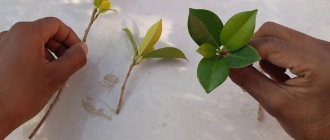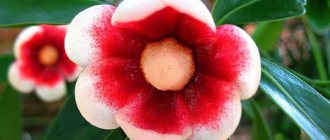What does a flower look like, what family does it belong to?
Ficus of this species belongs to the rubber family; it can grow quite tall. Under natural conditions, the plant is found in India and Indonesia. The shrub has large oval leaves. Under natural conditions, the length of the leaf varies from 20 to 30 cm. The color of the foliage is bright green with a beautiful white border. In some species, the stripes are located diagonally.
Rubber-bearing ficus grown at home
Description of ficus
At home, Ficus elastica Tineke grows up to 2 m in height and about a meter in width.
It has pointed, oval-shaped foliage, 25 cm long and 15 cm wide. The surface of the leaves is smooth, the color in the middle is green, closer to the edges it turns into white and cream. The trunk is green, the cuttings are light green. The young plant initially has one unbranched trunk. Gradually, aerial roots appear on it and its branches, which in a natural humid and warm environment reach the ground, forming new trunks.
Ficus elastica has large elliptical leaves with pointed ends. They are arranged alternately. The newly emerging leaves, as well as the stipules, are colored a rich dark brown color.
Caring for ficus Tineke at home
Caring for a ficus is not difficult, but if you ignore the rules, you can end up with an ugly, faded houseplant.
Temperature
Ficus rubber - home care
Ficus does not like the cold, since the climate in its homeland is very warm. The temperature in winter should not be below 5 degrees Celsius. In such cold weather, the foliage will turn black and the bush will die. High temperatures also often harm the flower. The optimal mode is +18… +25 degrees.
Lighting
Lighting for a flower does not play a special role. If the rubber ficus Tineke grows in the shade, then its foliage loses its variegation and becomes simply green. With a low amount of light, the plant will quickly shed its leaves and enter a state of sleep. It is better to place Ficus tineke closer to the window, and in the summer season take it out onto the balcony or into the garden.
Important! Do not allow direct sunlight to hit the ficus foliage.
Watering
The plant tolerates moist soil well; the soil should not dry out. At the same time, it is important not to flood the flower so that the root system is not damaged. The watering regime should completely depend on the climate zone. Features of flower irrigation:
- in summer, watering is done 3 times a day;
- in autumn and winter, moisturizing is reduced to several times a week;
- In the spring, active growth of ficus begins, so watering is carried out as needed.
Spraying
This procedure is very useful for the flower. During periods of severe drought or when the heating is turned on, it is simply necessary to regularly spray the plant. The procedure can be performed several times a week.
Suitable pots for planting Tineke
Humidity
Under natural conditions, ficus grows in well-humidified air, but the dryness of the apartment microclimate affects the flower negatively. With insufficient moisture, the foliage of the bush turns yellow and begins to fall off. This most often happens in apartments during the heating season, when radiators start working.
Priming
The flower prefers loose, fertile soil. If peat soil was purchased at a flower shop, then it is worth adding leaf soil and sand to it.
Important! You should not over-moisten the ficus soil, but you should not allow the earthen ball to dry out either.
Feeding
A complex of vitamins and minerals is necessary for Tineke. The most important components of mixtures for this crop are nitrogen and magnesium. Nitrogen will accelerate the growth of foliage, and magnesium will protect it from premature aging.
Rules of care
Basic care for the Tineke ficus includes a set of basic measures - properly organized watering, timely fertilizing, and annual pruning. Correctly selected care will be indicated by new leaves appearing weekly in long needles in spring and summer in the absence of falling of the lower ones.
Suitable soil
To grow mulberries, a nutrient substrate with increased air permeability and water absorption with neutral or weak acidity is required.
Lime and dolomite flour help reduce acidity. At the same time, dolomite simultaneously acts as a source of calcium and magnesium for flower crops.
The composition of the soil mixture depends on the age of the home color: for planting adult plants it is made denser, doubling the proportion of leaf soil, and for young plants it is made looser and lighter, mixing the soil with peat and coarse river sand (in equal quantities).
To increase aeration, expanded clay chips or charcoal are added, which are also used to organize the drainage layer necessary for ficus plants to avoid stagnation of moisture in the pot and prevent the appearance of root rot and the development of fungal diseases.
Watering
The crop needs regular but moderate watering:
- in summer, with active growth of vegetative mass - 2 or more times a week;
- in winter at the resting stage - in a reduced mode, up to 2 times a month.
Top dressing
Ficus grown in an inert substrate requires year-round feeding. In other cases, the flower crop is fed from spring to autumn, alternating the addition of organic matter and minerals at intervals of up to 2 times a month.
Ready-made complexes intended for decorative deciduous indoor plants are suitable for fertilization.
In spring, the main attention is focused on the active growth of green mass, which is facilitated by nitrogen. Before the cool season, home Tineka requires potassium and phosphorus, which increases the overall resistance of the flower to negative environmental factors.
Trimming
Pruning will help shape the shape of the crown
The best time for the procedure is spring, when the plant is actively growing. Ficus is trimmed for decorative purposes.
Technology:
- use a sharp knife to cut shoots down to 5-6 internodes to activate branching;
- the trunk is shortened to limit upward growth and stimulate the formation of lateral processes, while the trimmed top is suitable for subsequent rooting when propagated by cuttings;
- pinch the tops by hand.
Transfer
The indoor Tineka is replanted when its root system completely colonizes the pot space, growing through the drainage holes. For transplantation, select a new pot with a diameter 2-5 cm larger than the previous one. Preference should be given to containers made of clay or ceramics, without a decorative coating, the porous walls of which allow moisture and air to pass through well.
The most suitable method is transshipment.
Technology:
- the soil in the old pot is moistened to make it easier to get the earthen lump;
- the surface layer of the substrate is removed to a thickness of 2-3 cm;
- remove the ficus from the pot, shake off excess soil;
- Place in the center in a new pot, sprinkle with fresh soil mixture, and water.
Indoor mulberries over 4-5 years old are replanted no more than once every 3-4 years. For older plants, replanting is replaced by changing the surface layer of soil to a depth of 5 cm.
How does Ficus Tineke reproduce?
Ficus Melanie - home care
Reproduction of the crop occurs vegetatively. There are several options:
- cuttings;
- air layering;
- leaf rooting.
Rooting cuttings
The cutting must be at least 15 cm long. It is cut obliquely and placed in water for rooting. The procedure can also be carried out in wet sand. After receiving young roots, the plant is planted in a permanent place.
Air layering
The shoot is cut diagonally, and a match is inserted into it so that the stem does not overgrow. Moss is applied to the area, moistened and wrapped with film. When the first shoots appear, you can cut off the cuttings and plant them in separate pots.
Rooting a leaf
This method is considered the most ineffective. The leaf can be placed in water or soil for rooting. At best, you will get a leaf with roots, but you should not expect shoots.
Features of reproduction
Ficus trees are propagated by cuttings:
- Partially woody shoots are cut to obtain a cutting 10-15 cm long (at least 3-4 leaves). This is done with a well-sharpened knife.
- The upper leaves are trimmed, leaving 1/3 of the plate, carefully rolled, and the lower leaves are removed to reduce evaporation.
- Wash off the released juice.
- Place the cuttings in a container with water for 2-3 hours.
- The cut is dried.
After this, the cutting is placed in a jar of water. In this case, you need to ensure that the cut is above the surface of the liquid. You can immediately plant it in light, loose, moist soil. The container with the cuttings is covered with a cut-off plastic bottle or wrapped in polyethylene to create a mini greenhouse. This will increase the chances of rooting. You can begin to accustom Tineke to normal conditions after the appearance of the first young leaf. This is a sign that the plant has taken root and has roots.
Possible problems in cultivation and diseases
There are many reasons that cause the development of diseases in the ficus Tineke Elastica. Failure to comply with growing rules and ignoring basic rules of agricultural technology leads to a wide variety of problems.
The flower sheds its leaves
Falling leaves may indicate an incorrect watering regime; most likely the plant did not have enough moisture.
The leaves are turning pale
This occurs due to excess moisture. It is worth reviewing the watering regime.
The tips of the leaves are drying out
The tips of the leaves dry out and turn brown due to a lack of microelements in the soil or too dry air. The situation can be corrected by applying fertilizer and regular spraying.
Pests
Often the plant is attacked by pests such as scale insects, mealybugs and aphids. In this case, the flower must be treated with a soap solution and insects must be collected manually.
On a note! If treatment with soapy water does not help, then chemicals are used.
Reviews
According to astrologers, ficus is a Capricorn plant. It stabilizes the emotional background in the room and relieves anxiety symptoms. According to reviews from people who have a ficus at home, it should not be placed in a pan of water; this may be good for some plants, but not for ficus. Because of this, the lower roots become waterlogged, while the upper ones dry out. Therefore, you should water only from above, in good light and warmth. You need to let the top layer dry and then water it well.
If the leaves droop or spots appear on them, this means that the plant received too much moisture. If you properly care for ficus in apartments, you can decorate any decor in the house, as this ficus looks impressive. The main difficulty in care is providing a large plant with plenty of space in width and height.
To learn how to properly transplant a ficus tineke, watch the video below.
Signs and superstitions
It is believed that ficus brings positive energy to the house. For families in whose homes a flower grows, this promises well-being and financial prosperity. The Slavs attributed completely different characteristics to ficus. In their opinion, the plant is associated with evil spirits and brings only misfortune to its owners.
Healthy Tineke Flower
Ficus elastica Tineke is a highly ornamental plant. The flower has a lush crown that grows very quickly. Caring for the plant at home is quite simple, but extremely necessary. Even a beginner can grow this flower on his windowsill.
Trimming
If you do not want your ficus to reach its maximum size, then regular pruning is necessary. The crown is usually formed in the spring, when the most active growth of the plant is observed, so it can more easily tolerate this procedure. It is necessary to remember when starting pruning that ficus elastica has a poisonous milky sap that can irritate the skin.
When the plant reaches the height you want, pinch the main shoot. If you think that it is necessary to shorten the flower, then first cut the shoot five centimeters above the desired mark, and then pinch it. This will stop the growth in height and help form a lush crown.
Don't forget to disinfect your tools. Before pruning, the pruning shears and knife should be heated over a fire or treated with alcohol. After finishing work, remove the milky juice from the blade with a damp cloth or sponge. The spring formation of the crown activates the growth of new shoots and lateral buds.
The ficus crown and root system grow quite quickly. Therefore, in a couple of years, a flower can turn into a tree. This process can be curbed by reducing the volume of the pot and systematic pruning.
To give the ficus bush a shape, all new shoots are pinched at a level of 10-15 cm. This leads to the formation of side stems, which are subsequently also pinched. The shoots directed into the plant can be left untouched, but if the bush becomes too dense, some of them are cut out.
It is necessary to give the shape of a tree to those specimens that have a well-developed trunk. To do this, the side stems are completely removed. There remain those that are located on the top of the head in quantities from 5 to 7 pieces. Pinch them out after the plant reaches the desired height. Then, as the lateral shoots grow, the crown is formed.
Important! The cuts require special care. They are wiped with a soft cloth until the release of juice stops. Then it is treated with charcoal.
The flower is famous for its wide foliage and its rapid growth. If you don’t take care of the bush and don’t cut off the top part, then the ficus is quite capable of growing to the very ceiling. The plant is pruned for health purposes once every 3 years.
How to care for a plant after purchase
First of all, the tree is quarantined , since it is necessary to make sure that it is not sick or affected by pests. Quarantine is also required so that the plant adapts to new conditions and does not become infected if existing indoor plants are carriers of infections that they themselves do not manifest.
Attention: Moving to a new environment is stressful for a ficus, so it requires special attention in the first weeks after purchase.
After purchase, the ficus needs to be replanted, since
the land in which it was purchased is unsuitable for long-term cultivation .
To give the plant the most marketable appearance, it is saturated with additives that, with prolonged exposure, will kill it.
The transplant is carried out a week after purchase , when the ficus is already accustomed to new living conditions.
The plant is watered and carefully removed from the pot. After this, the store-bought soil is shaken off and the ficus is replanted in suitable soil. At the bottom of the pot, be sure to make drainage from expanded clay . The diameter of the new pot is 4 cm larger than the previous one.
Learn more about transplanting rubber ficus and caring for it in this video:











